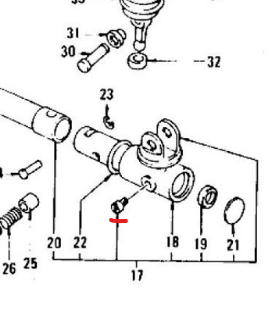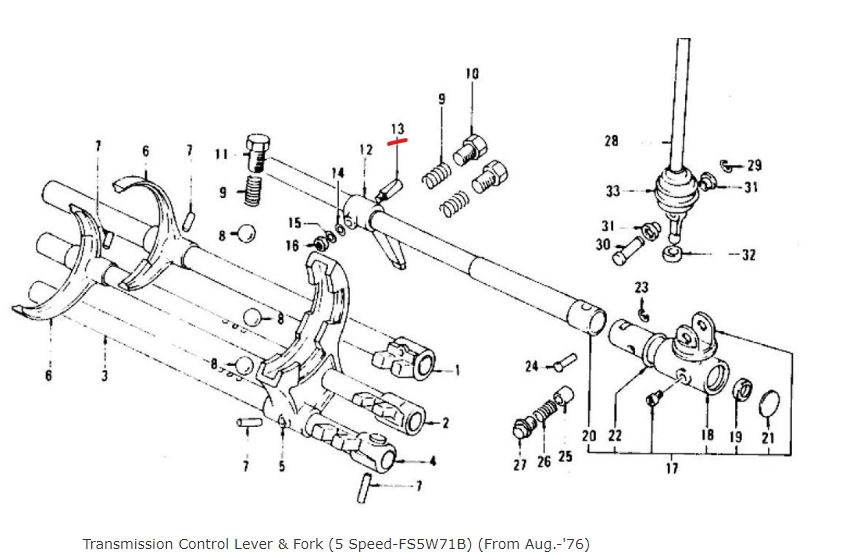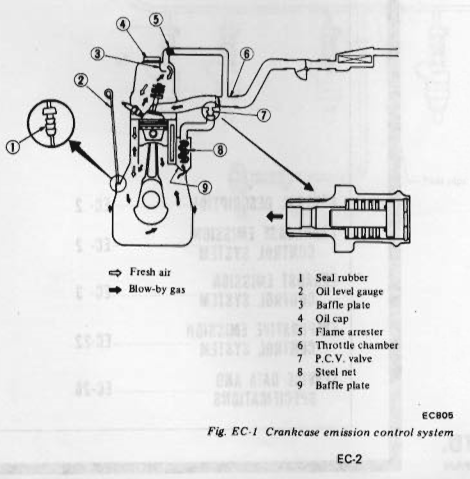Zed Head
Free Member
-
Joined
-
Last visited
-
Currently
Viewing Topic: L20a Engine Help
Everything posted by Zed Head
-
1978 5-speed transmission Tail-Housing Removal?
@zKars has the parts to be sacrificed, if he was interested. I think.
-
1978 5-speed transmission Tail-Housing Removal?
Looks like it might be a rivet. I'll bet you could grind the head off of it and the end would come off. Nissan never planned for this much disassembly, I'll bet, Might be some good stuff in the thread I found when I was looking for the picture. https://forums.nicoclub.com/transmission-stuck-in-first-gear-but-shifter-is-in-neutral-t602912.html
-
1978 5-speed transmission Tail-Housing Removal?
You're there...
-
1978 5-speed transmission Tail-Housing Removal?
-
1978 5-speed transmission Tail-Housing Removal?
Actually that's a good find. Maybe that's the one that leaks, not #22. It would be #19 in the parts manual. There's an o-ring, and an oil seal. It looks like the end of the striker rod should come off, exposing that oil seal. Maybe you can disassemble it without removing the rod. http://www.carpartsmanual.com/datsun/Z-1969-1978/power-train/transmission-control/5-speed
-
1978 5-speed transmission Tail-Housing Removal?
-
1978 5-speed transmission Tail-Housing Removal?
What's the number?
-
1978 5-speed transmission Tail-Housing Removal?
That is a good point. The only reason to remove the rod would be to replace the o-ring. Were it mine, I'd dribble some oil down the shaft and see if the o-ring leaks. If not, it doesn't need replacing. Welcome to the site ZBLUE1.
-
1978 5-speed transmission Tail-Housing Removal?
Is that some sort of orthogonal hammer driver?
-
1978 5-speed transmission Tail-Housing Removal?
Here's a drawing of the part. It's a wedge bolt like the kind that holds the pedals on to an upper-end bicycle. Wedging the part #12 against the case and twisting the rod might loosen the bolt. But, since it's a wedge shape, it will be wedged in there pretty tight. Wedges are powerful things.
-
What are the facts about 280z ECU compatibility and differences
Here's the FSM test procedure for 1978. It still uses engine cranking, but distributor spinning gives the same effect. I still think that there is another test procedure out there, maybe in the EFI Guide.
-
What are the facts about 280z ECU compatibility and differences
Breaking the Pin 1 circuit might work but the standard method is to make and break the coil circuit. Create a spark at the coil. Pin 1 needs to be connected to the circuit, of course, like it would be on the engine. Somewhere out there I think that there might be an actual Nissan write-up on it. Can't remember.
-
What are the facts about 280z ECU compatibility and differences
The three spark test supplies higher voltage to the EFI system than using the starter. Might be a clue. Plus it's quieter. Easier on the brain waves.
-
What are the facts about 280z ECU compatibility and differences
The FSM implies that the AFM signal is necessary but it must not need to be generated by the AFM. Since the engine will run with the AFM unplugged. The ECU just uses whatever is on those wires at the ECU connector. Open circuit seems to be enough.
-
What are the facts about 280z ECU compatibility and differences
You can get the ECU to open the injectors just by triggering three sparks, with the key on. If the circuit works. You could probably build a testing device with just power to the ECU, some lights on the injector grounding transistors and a voltage pulse to Pin 1. People often run their engines with the AFM unplugged. The base pulse is very basic, apparently it doesn't really need any sensor data. It's the starting point and all else is an addition to its length. Just saying, it's a simple input-output device. A scope would tell you base pulse length but might be more than needed to see if the ECU works or not.
-
What are the facts about 280z ECU compatibility and differences
It's just another reference point.
-
Crankcase to PCV Valve Hose
Can't that be measured? I wonder if a meter would show something. I had heard that the top hose was conductive, the black one. Might have got the PVC hoses mixed up. I didn't even know the silver color was a coating. I thought the material itself was silver. And that it was a silicone material. Maybe somebody painted a rubber hose silver on ea6's car and that's not even a Nissan hose. Anybody got a hose laying around and some solvent?
-
What are the facts about 280z ECU compatibility and differences
There's a reference to a Hybridz page in this thread that cygnusx1 supplied a while ago, that shows what some of the components do. Not in schematic form, but better than nothing. It's near the bottom of the Hybridz page. The link still works!
-
L28 full rebuild assembly
Nissan too, maybe. Your local Nissan dealer. http://www.carpartsmanual.com/datsun/Z-1969-1978/engine-280z/piston-crankshaft/21 https://www.courtesyparts.com/oem-parts/nissan-bolt-flywheel-1231542l11
-
Crankcase to PCV Valve Hose
I'd beat it on the garage floor, a rock, or a tree to break the stuff loose. Plug the ends if you don't want it to fly out.
-
Crankcase to PCV Valve Hose
ea6 is right, I believe. And PAtcon is right about the flame arrestor but it's in the valve cover hose. That silver PV hose is pretty big in diameter. Just stick a screwdriver in there and dig out the crud. And yes, they came in silver. you removed original paint.
-
L28 full rebuild assembly
It was a grammar joke. Nerdy. You said "figment" instead of fitment. Figment of imagination....
-
L28 full rebuild assembly
Are you sure you didn't just imagine it?
-
What are the facts about 280z ECU compatibility and differences
As far as the main inputs and outputs what would be different, to cause one to not work in any certain car. The fuel curve might be different, to work better with an automatic versus a manual, but the Pin 1 signal and the injector opening and closing should not be affected enough to cause major problems. Certainly not starting problems. These things aren't even computers, as we know them today. They're just parts in an automated system. Signals and measurements in, control signals out. The ECU can't tell what car it's in, they all look the same to it. The wiring diagrams for the EFI system don't even have any of the typical "auto" versus manual dotted lines, like the full car diagrams do. And. if you look at the chart in the first post, NMC and JECS don't even distinguish between them in the same way. JECS uses the same number for all of the MT cars, except for 75. NMC switches after 76. No rhyme, no reason. Also, didn't know this myself, there is no Federal 1975 car, apparently. I don't think that's right but the chart has nothing listed. Do all 75's have catalytic converters and EGR?
-
What are the facts about 280z ECU compatibility and differences
I tried ECU's from 75 to 78 on my 76 and they all worked. Might be that there's something wrong with that A11...000 ECU. I was lucky enough to have my car when lots of spare ECU's were floating around from a local guy, and I had a 76 original and a 78 parts car. All Federal models. I always tried spare parts in my car to be sure that they had value.













